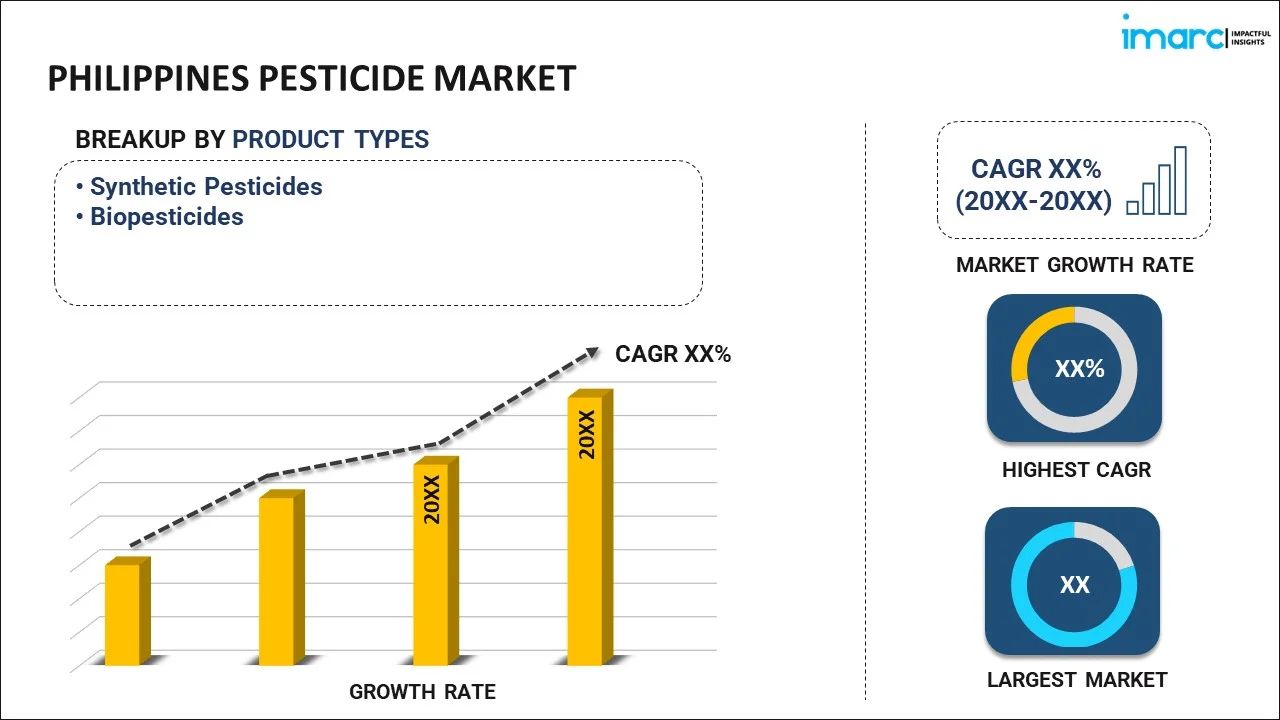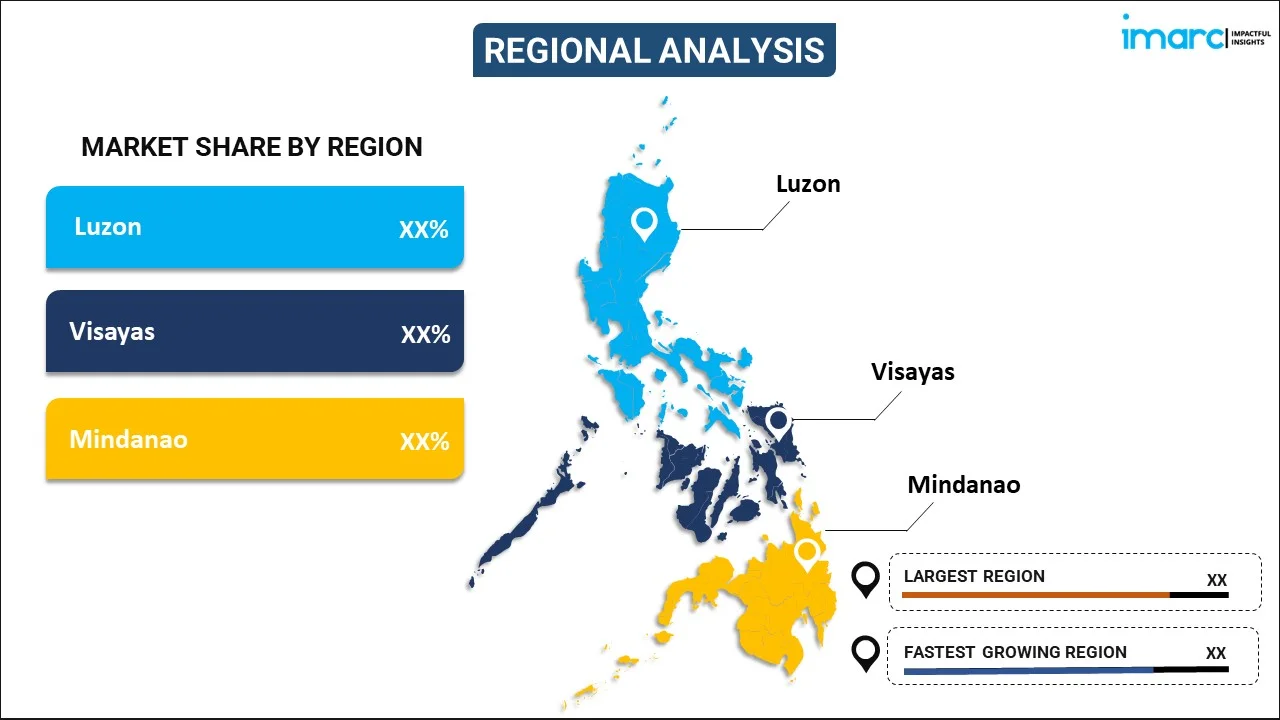
Philippines Pesticide Market Report by Product Type (Synthetic Pesticides, Biopesticides), Segment (Insecticides, Fungicides, Herbicides, and Others), Formulation (Liquid, Dry), Application (Pre-Harvest, Post-Harvest), Crop Type (Vegetables and Fruits, Oilseeds and Pulses, Cereals and Grains, Commercial Crops, Plantation Crops, and Others), and Region 2024-2032
Philippines Pesticide Market Overview:
The Philippines pesticide market is projected to exhibit a growth rate (CAGR) of 6.10% during 2024-2032. The market is currently expanding continuously due to the thriving agriculture sector because of an increase in population and consequently crop production, along with the growing urban population in the country.
|
Report Attribute
|
Key Statistics
|
|---|---|
|
Base Year
|
2023 |
|
Forecast Years
|
2024-2032
|
|
Historical Years
|
2018-2023
|
| Market Growth Rate (2024-2032) | 6.10% |
Philippines Pesticide Market Trends:
Thriving Agriculture Sector
According to an article published in 2023 on the website of the International Trade Administration (ITA), the agricultural sector accounted for 9.5% of the country’s gross domestic product (GDP) and around 20% of the country’s employment in 2022. A robust agriculture sector implies increasing crop output to feed the growing population and agricultural products for export. Due to an increase in crop production, farmers require pesticides to safeguard their produce from microorganisms, such as pests, diseases, and weeds, that can lead to a decline in production. Moreover, the increase in the agriculture business is putting pressure in acquiring more land for agricultural purposes. Such expansion often involves practices, such as deforestation or transformation of other forms of land into arable land. With larger areas under cultivation, there is a greater need for pesticides to control pests and diseases that may thrive in these new agricultural landscapes.
In line with this, there is production of many different crops, such as rice, corn, sugarcane, coconut and banana, in Philippines. Modern agriculture is dynamic, and producers are always searching for strategies to benefit most from this sector of the economy. However, different crops have their different pest and diseases, necessitating the use of a variety of pesticides to protect them effectively.
Growing Urban Population
An article published in 2024 on the website of the Central Intelligence Agency (CIA), the urban population of Philippines was 48.3% of total population in 2023. As urban populations are growing, so is the demand for food. This is leading to greater pressure on rural areas to produce more food crops. To meet this demand, farmers often resort to intensive agricultural practices, which may involve the use of pesticides to protect crops from pests and diseases and ensure higher yields. Furthermore, urbanization involves the expansion of cities and towns into surrounding rural areas, leading to the conversion of agricultural land into residential, commercial, and industrial areas. Such urbanization can remove natural habitats of pests and alter ecological balances, which makes pests move to food production regions. Due to this, farmers are forced to apply more pesticides to combat these pests and safeguard their produce.
Besides this, urbanization is leading to the shifts in food consumption patterns, including a greater consumption of processed and packaged foods. This change in diet preferences is driving the demand for cash crops like fruits and vegetables that require pesticide treatment to meet quality and safety standards during production and storage.
Philippines Pesticide Market News:
- April 2, 2024: The United States Department of Agriculture (USDA) along with CABI and the support of the Fertilizer and Pesticides Authority (FPA) of the Philippines conducted specialized technical training workshops in Manila for exploring recent concepts in residues and bio-efficacy assessments for pesticides registration.
- April 18, 2024: The International Rice Research Institute (IRRI) and the Department of Agriculture - Philippine Rice Research Institute (DA-PhilRice) launched the Drones4Rice Project during the Inception Workshop held at the IRRI Headquarters in Los Baños, Laguna. The Drones4Rice Project will craft standardized protocols for drone applications of seeds, fertilizers, and pesticides for rice production in the Philippines.
Philippines Pesticide Market Segmentation:
IMARC Group provides an analysis of the key trends in each segment of the market, along with forecasts at the country level for 2024-2032. Our report has categorized the market based on product type, segment, formulation, application and crop type.
Product Type Insights:

- Synthetic Pesticides
- Biopesticides
The report has provided a detailed breakup and analysis of the market based on the product type. This includes synthetic pesticides and biopesticides.
Segment Insights:
- Insecticides
- Fungicides
- Herbicides
- Others
A detailed breakup and analysis of the market based on the segment have also been provided in the report. This includes insecticides, fungicides, herbicides, and others.
Formulation Insights:
- Liquid
- Dry
The report has provided a detailed breakup and analysis of the market based on the formulation. This includes liquid and dry.
Application Insights:
- Pre-Harvest
- Post-Harvest
A detailed breakup and analysis of the market based on the application have also been provided in the report. This includes pre-harvest and post-harvest.
Crop Type Insights:
- Vegetables and Fruits
- Oilseeds and Pulses
- Cereals and Grains
- Commercial Crops
- Plantation Crops
- Others
The report has provided a detailed breakup and analysis of the market based on the crop type. This includes vegetables and fruits, oilseeds and pulses, cereals and grains, commercial crops, plantation crops, and others.
Regional Insights:

- Luzon
- Visayas
- Mindanao
The report has also provided a comprehensive analysis of all the major regional markets, which include Luzon, Visayas, and Mindanao.
Competitive Landscape:
The market research report has also provided a comprehensive analysis of the competitive landscape in the market. Competitive analysis such as market structure, key player positioning, top winning strategies, competitive dashboard, and company evaluation quadrant has been covered in the report. Also, detailed profiles of all major companies have been provided.
Philippines Pesticide Market Report Coverage:
| Report Features | Details |
|---|---|
| Base Year of the Analysis | 2023 |
| Historical Period | 2018-2023 |
| Forecast Period | 2024-2032 |
| Units | Million US$ |
| Scope of the Report | Exploration of Historical and Forecast Trends, Industry Catalysts and Challenges, Segment-Wise Historical and Predictive Market Assessment:
|
| Product Types Covered | Synthetic Pesticides, Biopesticides |
| Segments Covered | Insecticides, Fungicides, Herbicides, Others |
| Formulations Covered | Liquid, Dry |
| Applications Covered | Pre-Harvest, Post-Harvest |
| Crop Types Covered | Vegetables and Fruits, Oilseeds and Pulses, Cereals and Grains, Commercial Crops, Plantation Crops, Others |
| Regions Covered | Luzon, Visayas, Mindanao |
| Customization Scope | 10% Free Customization |
| Post-Sale Analyst Support | 10-12 Weeks |
| Delivery Format | PDF and Excel through Email (We can also provide the editable version of the report in PPT/Word format on special request) |
Key Questions Answered in This Report:
- How has the Philippines pesticide market performed so far and how will it perform in the coming years?
- What has been the impact of COVID-19 on the Philippines pesticide market?
- What is the breakup of the Philippines pesticide market on the basis of product type?
- What is the breakup of the Philippines pesticide market on the basis of segment?
- What is the breakup of the Philippines pesticide market on the basis of formulation?
- What is the breakup of the Philippines pesticide market on the basis of application?
- What is the breakup of the Philippines pesticide market on the basis of crop type?
- What are the various stages in the value chain of the Philippines pesticide market?
- What are the key driving factors and challenges in the Philippines pesticide?
- What is the structure of the Philippines pesticide market and who are the key players?
- What is the degree of competition in the Philippines pesticide market?
Key Benefits for Stakeholders:
- IMARC’s industry report offers a comprehensive quantitative analysis of various market segments, historical and current market trends, market forecasts, and dynamics of the Philippines pesticide market from 2018-2032.
- The research report provides the latest information on the market drivers, challenges, and opportunities in the Philippines pesticide market.
- Porter's five forces analysis assist stakeholders in assessing the impact of new entrants, competitive rivalry, supplier power, buyer power, and the threat of substitution. It helps stakeholders to analyze the level of competition within the Philippines pesticide industry and its attractiveness.
- Competitive landscape allows stakeholders to understand their competitive environment and provides an insight into the current positions of key players in the market.
Need more help?
- Speak to our experienced analysts for insights on the current market scenarios.
- Include additional segments and countries to customize the report as per your requirement.
- Gain an unparalleled competitive advantage in your domain by understanding how to utilize the report and positively impacting your operations and revenue.
- For further assistance, please connect with our analysts.
 Inquire Before Buying
Inquire Before Buying
 Speak to an Analyst
Speak to an Analyst
 Request Brochure
Request Brochure
 Request Customization
Request Customization




.webp)




.webp)












